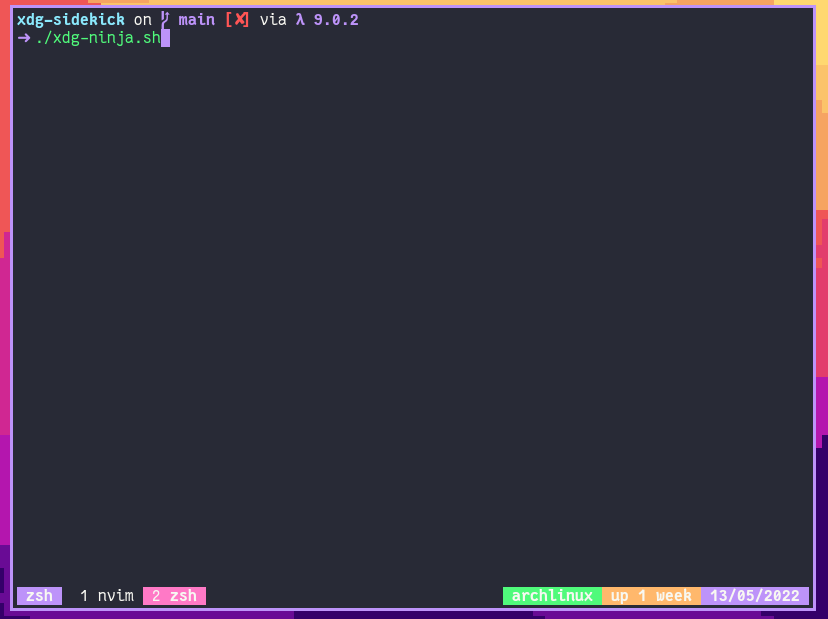Today, I would like to talk about XDG base directory specification
You can read the article, but the idea is a guidance for people creating and maintaining software programs.
What is all about ?
You should have noticed there are a lot of files starting with . in your home directory. Some are configuration files, some are cache, some are runtime data.
What is the problem ?
Well, it's a mess. Having all these files in your home folder is a bit strange, also not easy to follow if you have a dotfiles strategy.
Instead of having
~/.gitconfig
~/.tmux.conf
...
...
you could have
~/.config/git/config
~/.config/tmux/tmux.conf
...
This specification is progressively adopted, you will see a lot of files in ~/.config/ or ~/.cache folders. These two are the most commonly used by the programs.
So right now, a lot of programs started to support XDG base directory specifications, some made the choice to use directly the ~/.config to store config files, some simply argues they don't want to support them 🤦.
You can imagine the amount of mess
What are the benefits of using XDG
- it's cleaner
- you have one folder per program
- you can add a README.md file in each folder to take notes or to share information when sharing dotfiles on GitHub.
How to start ?
You can do it manually, by reading every program man files... or ... you can use tools that will report you the things you can migrate.
Here are my favorites:
xdg-ninja
Because you wouldn't let just anyone into your $HOME
A shell script that checks your $HOME for unwanted files and directories.
When xdg-ninja encounters a file or directory it knows about, it will tell you whether it's possible to move it to the appropriate location, and how to do it.
The configurations are from the arch wiki page on XDG_BASE_DIR, antidot (thanks to Scr0nch for writing a conversion tool), and crowdsourced by other users.
Installing
Manual Installation
Clone the repository, then run the ./xdg-ninja.sh script.
git clone https://github.com/b3nj5m1n/xdg-ninja
cd xdg-ninja
./xdg-ninja.sh
This will run every test in the default configuration.
Turn on flakes, then run the following command:
nix run github:b3nj5m1n/xdg-ninja
Note
Due to how xdg-ninja is developed, releases are not cut, so Homebrew ships a stale version, therefore you have to install and upgrade xdg-ninja from the git HEAD. ref: #204
Homebrew will not…
The first one is only about reporting current status about each dotfile. It also reports a status for files that are currently unsupported, or when developers declined to support XDG.
It provides you information on how to migrate them.
This one is very cool, because it will never simply make no change to your dotfiles.
 doron-cohen
/
antidot
doron-cohen
/
antidot
Cleans up your $HOME from those pesky dotfiles
antidot 🏠 🔸 💥
Cleans up your $HOME from those pesky dotfiles.
Migration from Pre 0.6.0 Versions
Please backup your environment variable and aliases files (in $XDG_DATA_HOME/antidot/{env,alias}.*). After version 0.6.0 antidot stores env exports and alias definitions in a JSON file and generates from it shell definition files.
Intro
For years I stood by and saw how countless applications populate my home dir with dotfiles.
No more! antidot is a tool to automatically detect and remove dotfiles from $HOME without any risks. It will move files to more appropriate locations (based on XDG base directory specifications). It will also set environment variables, declare aliases and use symlinks to ensure apps can find their files.
Installation
Arch Linux
yay -Sy antidot-bin
Homebrew
brew install doron-cohen/tap/antidot
Go to the releases section and grab the one that fits your OS.
After installing run antidot update to download the latest rules file…
This one is about listing them, it reports a bit less results.
But it can help you to migrate them automatically.








Top comments (4)
here are similar movement with .dotfiles on macOS - I added a link to your article:
github.com/pi0/config-dir/discussi...
Thanks for sharing this, didn't know about xdg-ninja !
it's true am handling everything in my ~/.config dir manually except for tmux.conf and gitconfig, am lazy ya know...🙈... but i will definetlly change that !
👍 Will definitely look it to the
.config/gitThere's also the--systemlocation/etc/gitconfig. Making things really global, and just keep personal stuff/info in the other one.Yes, it's possible to have clean config files and home folder. It's just a pity that's not the default behavior